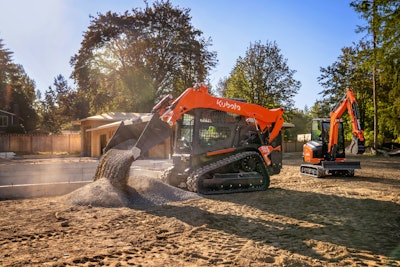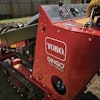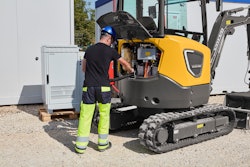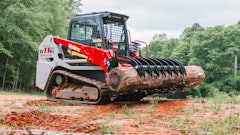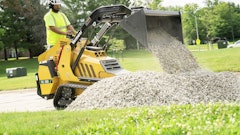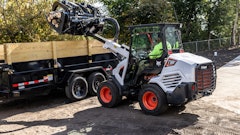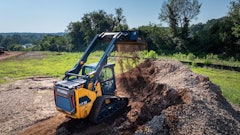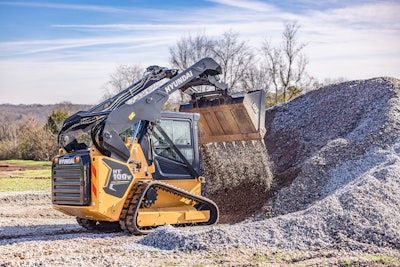
The construction contractors’ ability to maximize productivity while minimizing expenses directly impacts their potential for business growth. Heavy equipment owners and operators need resources to increase their efficiency and stay competitive amid a continuing skilled labor shortage. "Do more with less" is the means to success.
More contractors are turning to the machine that can seemingly do it all: the compact track loader (CTL). With its low ground pressure and ability to operate a vast array of attachments, the CTL handles an impressive number of applications in a compact package that many contractors consider to be easy to use and learn.
These attributes earn the CTL’s position as one of the fastest growing, construction heavy equipment segments. According to Transparency Market Research, the CTL market, which was worth $27.5 billion in 2022, is expected to grow at a compound annual growth rate of 5.2% to reach $43.6 billion in sales by 2031.
While it’s clear the machine is gaining popularity for good reason, consumers will want a proper understanding of CTLs to help determine if it’s right for them and how to get the most out of it. This article examines the CTL’s benefits, challenges and capabilities.
Complete Versatility
 Yanmar's TL65RS, TL75VS, TL80VS and TL100VS models can all be outfitted with the ability to automatically level the load while raising and lowering the boom.Yanmar Compact Equipment North America
Yanmar's TL65RS, TL75VS, TL80VS and TL100VS models can all be outfitted with the ability to automatically level the load while raising and lowering the boom.Yanmar Compact Equipment North America
“The lifting capacity and the hydraulic power of those machines translate to being able to run a … wide variety of attachments, making it … [a] versatile machine,” said Emily Pagura, solutions marketing manager, John Deere.
The CTL’s ability to use many attachments—from buckets to augers to laser grading systems—makes it an attractive option. However, the low ground pressure offered by the machine’s tracks is what sets the CTL apart from other compact equipment, such as skid steers or compact wheel loaders, in terms of worksite flexibility.
The large surface area of tracks inherently provides CTLs with better flotation and maneuverability on uneven terrains and softer grounds like sand or mud than wheeled loaders. Tracks also provide low ground pressure, making CTLs less likely to tear up the turf on jobsites than wheels, according to Doug Clark product manager of compact equipment, Wacker Neuson.
“Tracked models are more efficient on softer ground. Having said that, the track platform also generally allows for greater tractive force on unstable surfaces like sand,” said Clark. “They are far better on broken ground than wheeled units, while only being slightly less maneuverable on concrete or asphalt.”
The CTL’s ability to perform well across different terrains and operate different attachments makes it a solid fit for many applications, including earthmoving, snow removal, paving, landscaping and hardscaping. For example, Pagura explains the CTL’s handling of uneven terrains makes it useful for vegetation management projects with attachments like stump shredders, mulching heads and rotary cutters.
“To be able to do all of that with one machine just gives the contractors the opportunity to do a lot of different types of work,” said Pagura.
Strong ROI
In addition to a competitive edge, CTLs offer contractors a positive return on investment (ROI). Like most compact equipment, new CTLs can be purchased for tens of thousands of dollars, while new large heavy equipment like excavators and bulldozers—which may be used for similar tasks—typically run upwards of $100,000.
“There is a much lower total cost of ownership when compared to larger machines,” said Adam Ford, product manager for Hyundai Construction Equipment Americas, which announced its re-entry into the CTL market with the HT100V at last year’s CONEXPO-CON/AGG (CONEXPO).
He believes the CTL’s reliability and cost of service are two major benefits consumers should consider. The machine is easier to service when compared to larger machines, primarily because of the CTL’s small size and “the nature of its architecture when it comes to hydraulics and how the power chain is laid out.”
According to Ford, the CTL makes financial sense when considering its usage rate. Contractors will get more for their investment in the machine than they might from large, dedicated equipment, because of its versatility.
“When [contractors are] looking at their fleet, they're looking at how often this piece of machinery is being utilized,” he said. “The CTL utilization rate is going to be much, much higher than a machine that is only used for one specific function at one point in the job.”
The CTL can tackle a range of jobs, whereas “without a CTL, you have to have bespoke machines to do each separate task.”
Increased Efficiency for All Skill Levels
The ongoing shortage of skilled laborers is a factor for many contractors considering a new machine for their fleet. New machines often come with a learning curve, even for more experienced operators.
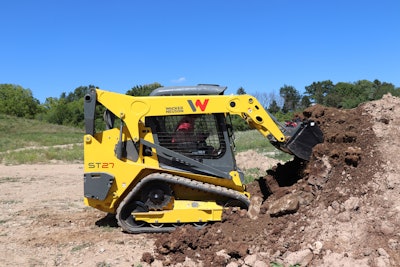 A CTL's size and complexity level may be less intimidating for a beginner.Wacker Neuson
A CTL's size and complexity level may be less intimidating for a beginner.Wacker Neuson
- Return to position automation – Many equipment makers provide the capability to outfit their CTLs to automate specific movements, such as with John Deere's EH Boom Performance Package. "This allows the operator to preset positions for return to dig, return to carry and boom height kick out," said Pagura, adding that automating sequences of repetitive tasks "lets an operator get that right every time," eliminating the risk of operator error. The productivity-boosting feature is available as a factory-installed option on Deere's 331G and 333G CTLs and will be available on the upcoming P-Tier large-frame CTLs, the 331 P-Tier, 333 P-Tier and 335 P-Tier, which are slated for release in summer 2024.
- Self-leveling technology – Similar to return to position, self-leveling technology keeps the bucket level for the operator to prevent the loss of materials while the boom is in motion. Many equipment producers make this feature available on CTLs. “Automating the more methodical processes gives the operator the ability to focus on other aspects of the machine to create a safer and more efficient worksite,” said Peter Ovrebo, product management director, Yanmar Compact Equipment North America. Yanmar entered the CTL market for the first time at last year’s CONEXPO, with its TL65RS, TL75VS, TL80VS and TL100VS models, which can all be outfitted with the ability to automatically level the load while raising and lowering the boom.
- Grade-assist technology – Grading can also be automated on some CTLs. With grade assist, the machine automatically adjusts the attachment position for a final grade, which can be a challenging manual task for a rookie. Deere offers this capability with SmartGrade, a full 3D grade control that is currently available on the 333G and will be available on the upcoming P-Tier models.
 Kubota's SVL75-3's screen displays the CTL's standard rearview camera, the battery charge, hydraulic oil and coolant temperature, auxiliary mode, and fuel levelKubota
Kubota's SVL75-3's screen displays the CTL's standard rearview camera, the battery charge, hydraulic oil and coolant temperature, auxiliary mode, and fuel levelKubota- Fully electric. “To bring the T7X to life, we partnered with Moog, Inc., a worldwide developer of motion control components and systems for industries ranging from aerospace and defense to construction. Together, we took a holistic view of the machine’s system, which is what enabled us to engineer a purely electric solution,” said Joel Honeyman, vice president of global innovation, Doosan Bobcat.
Maintenance Requirements
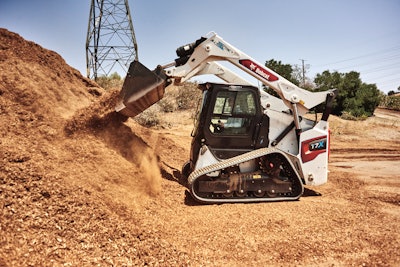 The T7X compact track loader is a purely electric solution.Bobcat
The T7X compact track loader is a purely electric solution.Bobcat
“The tracks on the CTL’s undercarriage just adds another system that you need to maintain and do preventative maintenance for,” said Pagura.
The best way to overcome the potential maintenance issues is to stay ahead of them. Contractors can be proactive by conducting preventive maintenance on schedule and inspecting the tracks daily. Pagura said these daily checks should include cleaning the track system and frame; removing debris; and examining the tracks for signs of damage, which will present differently than with wheels.
“You're looking for any cracking, anything that's starting to look dry or excessively worn down. You're looking for uneven wear from the outside to the inside of the track,” she said. “Having an operator doing this regularly can help you identify issues before they create downtime.”
Understanding how track machines drive on different terrains can also help contractors preserve track integrity. For example, operators should take special care on concrete or asphalt. According to Pagura, while CTLs can handle paved surfaces, “a lot of skidding or sharp turning is going to wear down … tracks faster.”
Contractors can also mitigate the risk of unexpected maintenance issues and downtime by using advanced monitoring systems. Deere’s CTLs come standard with perpetual access to John Deere’s Operations Center, which was formerly known as JDLink. The telematics system tracks the machines’ health and can provide owners with notifications of diagnostic trouble codes via the machine display and mobile device.
Each of Yanmar’s CTLs can incorporate optional SmartAssist telematics for error detection and notifications and real-time updates on the machine’s operational status and productivity.
Theft
One risk contractors should be aware of is the CTL’s potential for theft. While CTLs are not known to be more susceptible to theft than any other compact equipment, the machine’s “benefit of being easy to move does make it easy to steal,” according to Ford.
Fortunately, owners can take several actions to better protect their assets:
- Ovrebo said, “Common sense goes a long way.” With that, owners should take common sense measures, such as always ensuring that the machine is locked up, the battery switch is turned off and the key is removed.
- Since the machine is easy to transport, operators should do what they can to make transportation more challenging for thieves. Ovrebo suggests blocking the CTL and keeping it out of sight of passersby.
- Some CTLs are equipped with the ability to establish custom pins for owners and operators. For example, Yanmar’s Ignition Interlock requires operators to enter their custom pin using the touchscreen display to start the machine.
- Another benefit of machine telematics that many modern CTLs offer is the ability to track the machine’s location. Hyundai’s HI-MATE telematics solution, which comes standard on its HT100V, will notify the owner or fleet manager if the CTL has been moved after work hours and can track its location in near real-time. According to Ford, HI-MATE has been used in conjunction with law enforcement to successfully locate stolen machines.
Make the Choice: Understand the CTL’s Capabilities
While the benefits and challenges of CTLs may be clear cut, contractors that ensure a match between the CTL’s machine capabilities and their needs will optimize their productivity, efficiency and ROI.
This is where dealers and rental houses have an important job to do.
“Helping the customer identify what their job is going to be and making sure that a CTL is a good fit is key,” said Ovrebo.
Communicating the machine’s capabilities and limitations will help contractors determine if different equipment is a better match. For example, a skid steer may offer more in terms of maneuverability and agility thanks to its wheels. When compared to a compact wheel loader, CTLs typically have lower lift heights and lift capacities.
However, CTLs can offer a wide range of lift capacities depending on the size class, which also impacts operating weight, horsepower, maneuverability and attachment compatibility.
“I think any size could be a great addition to a jobsite,” said Pagura. “But it is important to match the machine to the space you have and the task at hand, and more specifically, to the attachments that you'll be running.”
